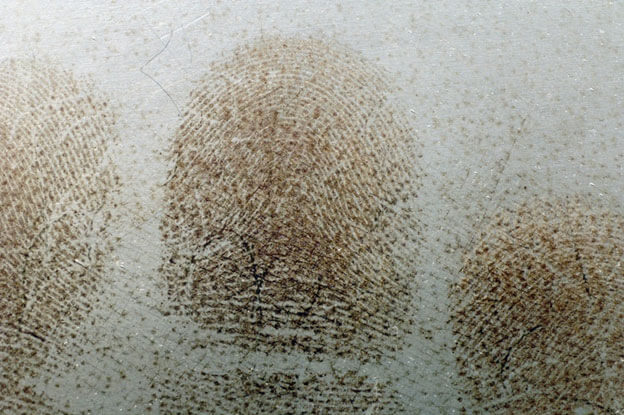
by Kourosh Nikoui | July 19, 2024 | Fingerprints
Fingerprints are invaluable forensic evidence, often serving as a key to unlocking mysteries surrounding criminal activities. While recovering fingerprints from solid surfaces like glass and metal is routine, extracting them from human skin poses unique challenges. In this blog article, we delve into the methodologies behind recovering fingerprints from human skin and explore gripping cases where this evidence led to the identification of murderers.
The human skin presents a complex landscape for fingerprint recovery due to its elasticity, moisture, and texture. Here are some of the challenges forensic investigators face:
Texture Variation: The uneven surface of human skin makes it difficult to capture clear and complete fingerprints. The varying topography can result in partial or smeared prints, complicating the analysis.
Moisture Content: Sweat and natural oils on the skin can obscure or distort fingerprint ridges. These fluids can cause smudging or create barriers that prevent fingerprint powders and chemicals from adhering properly.
Post-Mortem Changes: In cases involving deceased individuals, skin decomposition can rapidly alter the condition of the skin, affecting the quality of fingerprints. Decomposition can cause the skin to become more fragile and less receptive to traditional fingerprint recovery methods.
Forensic scientists employ various techniques to recover fingerprints from human skin, each with its own advantages and limitations:
In the early 2000s, a young woman was found deceased in her apartment with signs of manual strangulation. Investigators suspected the perpetrator’s fingerprints might be present on the victim’s neck. Through meticulous forensic analysis, partial fingerprints were successfully recovered using cyanoacrylate fuming and fluorescent dye. These prints were matched to a suspect in the criminal database, leading to their arrest and conviction.
In a separate case, a body was discovered in an advanced state of decomposition in a remote wooded area. The victim’s identity and cause of death were initially unknown. Forensic investigators faced the daunting task of recovering usable fingerprints from the decomposed skin. Utilizing a combination of superglue fuming and iodine silverplate transfer, they managed to obtain partial prints. These were then enhanced with magnetic fluorescent powder to increase visibility. The recovered fingerprints were run through a national database, resulting in a match to a missing person reported several months prior. Further investigation led to the identification of a suspect, who was eventually convicted based on the fingerprint evidence and additional corroborating facts.
Recovering fingerprints from human skin presents a formidable challenge in forensic investigations. However, advancements in techniques such as powder dusting, superglue fuming, chemical reagents, and fluorescent powder offer promising avenues for success. Real-life cases, like the ones mentioned above, underscore the critical role of fingerprint recovery in solving crimes and delivering justice.
A forensic investigator, a fingerprint analyst or a crime scene investigator, rely on these advanced methods to ensure the accuracy and reliability of their findings. As forensic science continues to evolve, the ability to extract and analyze fingerprints from human skin will undoubtedly advance, further empowering law enforcement agencies in their pursuit of truth.
Understanding these techniques not only highlights the complexities involved in forensic investigations but also showcases the dedication and expertise required to bring justice to victims and their families. With ongoing research and technological advancements, the future of fingerprint analysis looks promising, offering new tools and methods to tackle even the most challenging cases.
Forensic Investigator and Specialist Kourosh Nikoui, Principal Consultant and CEO of Nikoui & Associates, Forensic Identification Services & Consulting, Inc., has over 38 years of full-time experience in forensic science and criminal justice with various law enforcement agencies, government and private entities. Mr. Nikoui, a court-qualified expert, is a Certified Latent Print Examiner, Certified Senior Crime Scene Analyst, and Certified Forensic Photographer by the International Association for Identification. He has testified as an expert witness over 150 times in California Superior and U.S. Federal Courts, processed evidence in over 30,000 criminal and civilian cases, and served as a consultant to numerous law enforcement agencies. Mr. Nikoui holds a BFA degree from USD and is an active member of multiple forensic science organizations. He can be reached directly by calling (866)439-6753 or by email at [email protected]